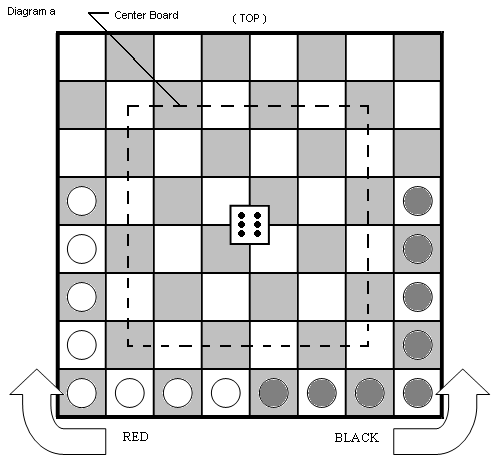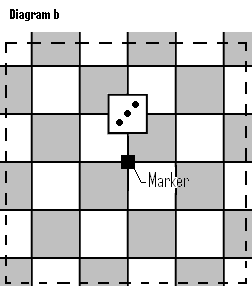
OP∙Position
Copyright©
October 2003
A PyroMyth game for 2 or 3 players*
· 1 standard eight-by-eight checker board
· 8 red checkers
· 8 black checkers
· 1 standard six-sided die
· 24 markers (Pennies or bingo chips work nicely.)
Capture four checkers of one color or three checkers of each color.
First, determine the player order by rolling the die. The player who rolled the highest number goes first, the second highest goes second, and so on. If there are any ties, everyone re-rolls to determine the starting order.
After the play order
is determined, place the die on the center intersection of the board
with the six facing up and the four facing the top of the board. Place
the checkers as shown in Diagram a.

Each turn consists of two phases: moving a checker and tipping the die. Both phases are mandatory.
Move
a Checker
Each player, as the first part of his or her turn, must move a checker if a legal move is available. The moved checker may be of either color. Red checkers move clockwise and black checkers move counter-clockwise along the outer ring of the board. Checkers are always moved a number of spaces exactly equal to the number displayed on the top face of the die, with these further conditions:
1. If the moved checker lands on a space occupied by a checker of the opposite color, the checker that was landed upon is captured. A checker may never capture a checker of its own color.
2. During its move, a checker may freely pass over any number of empty spaces and any number of checkers of the opposite color. But a checker may not pass over any checkers of its own color unless a capture is made.
3. If a capture is made, the player may continue moving (but is not obliged to move) the same checker again, provided that another capture is made. Multiple captures may be possible.
Each player, as the second part of his or her turn, must tip the die within the confines of the five by five grid of intersections that make up the center of the board. The die tips from one intersection to any empty orthogonally adjacent intersection by tumbling onto one of its sides. After the die is tipped, a marker is placed on the intersection that the die previously occupied. If there are no available places to tip the die (i.e., if it is surrounded on all sides by markers and the outer row of the board), the player removes any marker instead.
Example: From
the starting position in Diagram a, tipping the die one intersection
toward the top of the board results in a three as shown in Diagram b.

*Special thanks to Clark Rodeffer for all his help with play testing and with the editing of the rules.